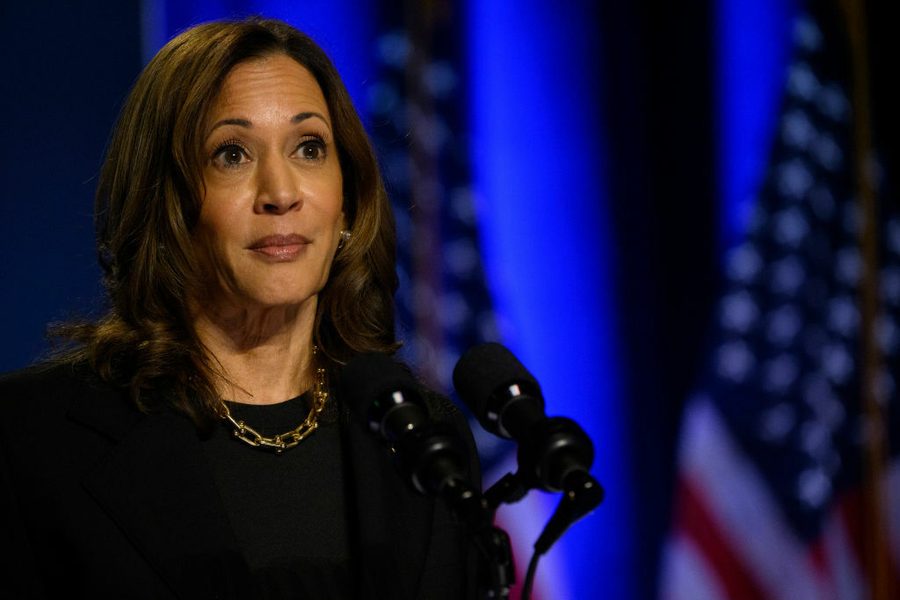The Warning Signs for Kamala Harris's Campaign Are Flashing Red
With only weeks left until Election Day, Harris can go from underdog to frontrunner by winning over working-class and anti-war voters.
Miles Kampf-Lassin

Since Vice President Kamala Harris took the reins at the top of the Democratic ticket in late July, she has repeatedly declared: “We’re the underdogs.”
Even after a stretch of positive media coverage, a widely praised Democratic National Convention and a debate performance in which she dominated former President Donald Trump, Harris has continued to cast her campaign as a longshot.
Why the handwringing, when Harris is polling far better than President Joe Biden was before he dropped out of the race?
Some pundits have stacked it up to a savvy get-out-the-vote strategy. But the race really is that close: Especially in decisive swing states, the Harris campaign is, in many ways, the underdog. And considering the far larger size of Biden’s 2020 lead — and how narrow his win turned out to be — Democrats have every reason to worry.
Trump is a uniquely flawed candidate and his dismal record in office is easy to excoriate, as Harris demonstrated during the September debate. His presidency showered the rich with tax cuts, squeezed working people, offshored jobs, terrorized immigrant communities and failed to respond to a pandemic that led to mass preventable death and turned the economy upside down. The Supreme Court justices he appointed have curtailed reproductive rights and targeted the entire regulatory apparatus. And the far Right’s Project 2025 playbook promises to roll back decades of progressive reforms, from voting access to LGBTQ rights.
What’s more, Trump has promised a regime of vengeance that would directly target journalists, organizers and anyone considered a political enemy.
Still, Harris has not yet rebuilt the fragile coalition that pushed Biden over the finish line four years ago. Compared with Biden in 2020, polls show Harris underperforming with voters of color, younger voters and seniors — all key for Democrats. And when it comes to lower-income voters and those with less formal education, Harris is being outrun.
A second Trump term would mean economic mayhem for the working class and a disaster for the labor movement. Yet, according to CNN political analyst Harry Enten, “Trump has more working-class support than any GOP presidential candidate in a generation,” while Harris is poised to have the worst Democratic performance among union voters in decades.
Among Arab American voters, support for Harris has cratered as the U.S.-backed genocide in Gaza continues, with Israel expanding its assault into Lebanon. A mid-September poll from the Arab American Institute (AAI) shows that, among likely Arab American voters, Trump leads Harris 46% to 42%, a far cry from 2020, when Biden won nearly 60% support. Many of these voters say the war on Gaza is a prime concern — and they could be won over with a change in policy.
In Michigan, home to a significant Arab American population including Palestinian and Lebanese families, internal polling shows Harris is “underwater,” according to Rep. Elissa Slotkin (D-Mich.). Based on publicly released polls, the state is a toss-up at best. The Uncommitted National Movement, which drew more than 100,000 voters in the Michigan Democratic primary, has refused to endorse Harris due to her continued support of “unconditional weapons” for Israel’s campaign of annihilation. (Hillary Clinton lost Michigan by around 10,000 votes in 2016; Biden won it by 150,000.)
These underlying dynamics should ring alarm bells for a Democratic campaign entering the final stretch of a cardinal race with potentially catastrophic consequences. If Democrats take the authoritarian threat posed by Trump as seriously as they profess, they need to change course in order to cobble together a cross-section of voters who can vault Harris into the Oval Office.
That change should start with promising a shift away from unflinching sponsorship of Israel’s military offensives. Seven in 10 likely voters want to see a ceasefire in Gaza, which will require forcing the hand of Israeli Prime Minister Benjamin Netanyahu, including by conditioning arms in line with international and U.S. law. Polling from AAI suggests that backing these restrictions would make 56% of Arab American voters more likely to support Harris.
Netanyahu has proven time and again he is unwilling to reach peace; Harris can promise to use U.S. leverage to make him. This move, backed by a majority of Americans, would help make inroads among a vast stratum of voters — including those in Michigan, Wisconsin and other swing states — eager to support the Democratic nominee if the party would simply stop underwriting a genocide. It’s also the morally correct position — tens of thousands of Palestinian women and children have already been slaughtered by American weapons, and the Netanyahu government appears dead set on not just continuing but expanding its onslaught.
On the economy, Harris could depart from her recent approach of cozying-up with crypto financiers and wealthy business interests by instead leaning into the populist, class-war rhetoric and policy planks Democratic voters have responded to in the post-Obama era. Harris has embraced good policies like reviving the expanded child tax credit, building millions of new housing units, continuing to invest in green manufacturing and going after price-gouging companies. But with a majority of the population living paycheck to paycheck, working-class Americans are in desperate need of a bold redistributive agenda that would materially improve their lives right now. Targeting the elites and billionaires is an effective strategy to win over lower income voters, and while Harris has adopted appeals in this direction to acknowledge economic grievances, there’s more runway left to address them.
Harris could make central in her campaign the extremely popular positions already in the 2024 Democratic Party platform — such as a federal $15 minimum wage; capping out-of-pocket drug costs while forcing the pharmaceutical industry to lower prices; expanding Social Security; limiting rent increases by corporate landlords; and passing the PRO Act to massively grow union membership.
In these final weeks of the campaign, Harris can take a big swing by doing more to champion the pro-working class policies her party nominally supports — in speeches, ads and voter appeals. As the 2020 campaign drew to a close, Biden took such a pro-worker message to the stump and went on to prevail in the “blue wall” states of Michigan, Wisconsin and Pennsylvania.
These progressive realignments by Harris would also help vitalize the get-out-the-vote operations that were pivotal to Biden’s victory four years ago when young voters helped clinch swing states by coming out in droves. This year, youth voter registration is lagging behind 2020, and top Democratic groups are privately fretting that the lack of meaningful outreach to young people of color could cost them the election. In focus groups, younger voters cite concerns about the economy as well as the assault on Gaza as motivating factors in their decision. Compelling them to not just vote but also knock doors, travel to swing states and make calls should be a top priority.
Unlike campaigning alongside Republicans, as Harris has recently done, shifting to the left could also bring new energy to the constellation of grassroots organizations that engineered Biden’s Covid-era ground game in critical battleground states. The Sunrise Movement, the Working Families Party, People’s Action, Seed the Vote and Black Voters Matter have announced major electoral outreach efforts in swing states, which is welcome news for Democrats. But their work could have a larger impact if the Harris campaign makes concrete efforts to win over the now disaffected voters Democrats counted on last time. In a recent canvass led by SEIU Local 32BJ in Pennsylvania, for example, The New Yorker reports that “plenty of working-class Philadelphians had reservations about Harris.” Taming those doubts is the task at hand.
Biden’s exit offered Democrats a new direction and a real shot at defeating a despotic, revenge-fueled union buster in Trump. Harris still has a chance to respond to the clear warning signs that have made her the underdog. She should take it.
Disclosure: Views expressed are those of the writer. As a 501©3 nonprofit, In These Times does not support or oppose any candidate for public office
Miles Kampf-Lassin is Senior Editor at In These Times. Follow him at @MilesKLassin











